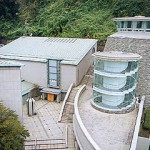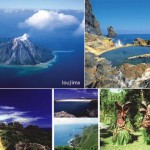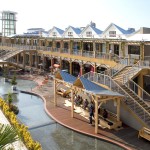++++++++ CONTENTS ++++++++
Origin of the Seven Herbs of Autumn
秋のThe Seven Herbs of Autumn
Hagi / 萩 (Bush Clover)
Obana / 尾花 (Japanese Silver Grass)
Kuzu / 葛 (Kudze)
Nadeshiko / 撫子 (Fringed Pink)
Ominaeshi / 女郎花 (Patrinia)
Fujibakama / 藤袴 (Joe-Pye weed)
Kikyo / 桔梗 (Balloon Flower)
The Seven Autumn Herbs Other Than the Above
Hirugao / 昼顔 (Japanese Bindweed)
Mukuge / 木槿 (Rose of Sharon)
In autumn, silver grass shines in the sunlight in the fields and mountains.
Did you know that this silver grass is one of the seven herbs of autumn?
It is also called “obana”.
Unlike the seven herbs of spring, the seven herbs of autumn are not associated with any particular event but they are deeply rooted in Japanese life and are used as food and medicine.
Many people think of the seven herbs of spring used in rice porridge, but the word “nanakusa (the seven herbs)” originally refers to the seven herbs of autumn and is said to have originated from a poem written by Yamanoue-no Okura around 700 AD.
かき数ふれば 七種(ななくさ)の花
(Aki-no No-ni Sakitaru Hana-wo Oyobiori
Kakikazoureba Nanakusa-no Hana)
Meaning: When I count on my fingers the flowers that bloom in the autumn fields, I find there are seven.
萩の花 尾花 葛花 瞿麦の花 姫部志
また藤袴 朝貌の花
(Hagi-no Hana, Obana, Kuzuhana, Nadeshiko-no Hana, Ominaeshi, Mata Fujihakama, Asagao-no Hana)
Meaning: Bush clover, Japanese silver grass, Kudze, Fringed Pink, Patrinia, thoroughwort, and Balloon Flower.
*There are various theories about the last flower “asagao,” but the most popular one is that it is a balloon flower.
Yamanoue-no Okura was an aristocrat in the early Nara period (710-794), and his 78 poems are included in the Manyoshu (8th-century anthology of Japanese poetry).
Flowers that bloom in the wild and have no name become familiar and special once you know their names. Have you ever had such an experience?
Let’s learn the seven herbs of autumn and make them special flowers.
You may also think back to the world of Manyo.
Note: Some say that the seven herbs of autumn are bush clover, Japanese silver grass, kudzu, Fringed Pink, Rose of Sharon, Chinese balloon flower, and Japanese Bindweed.
Hagi / 萩 (Bush Clover)
Hagi (Japanese bush clover) sways in the autumn fields and mountains. The flowers are small butterfly-like, and come in red, purple, white, and other colors. The name “ohagi,” a rice cake with red bean paste prepared on the Higan (autumnal equinox week), came about because this is the time when the flowers bloom. Incidentally, the same food is called “botamochi” in the spring on Higan (vernal equinox week), when peonies are in bloom.

Obana / 尾花 (Japanese Silver Grass)
The word “obana” is used in the proverb, “I thought it was a ghost, but on closer inspection, it turned out to be withered silver grass. This “o-bana” refers to the Japanese silver grass.
Japanese silver grass shining in the autumn sun are very beautiful.
It is also an indispensable offering for tsukimi (moon viewing).

Kuzu / 葛 (Kudze)
Kudzu is a legume that vigorously spreads. It has vines that wrap around trees and other plants. The flowers are purple and butterfly-like and are borne in clusters of about 20 cm.It is a nuisance because it can kill trees.
But in Japan, it has been used as food and medicine.
Kuzu flour is made by refining the starch from the roots of this plant. It is used to thicken confectionery dough and food and is also drunk to warm the body.
Sesame tofu is made from this kudzu powder, not soybeans.
Kuzu root is also used in Chinese herbal medicine.

Nadeshiko / 撫子 (Fringed Pink)
Nadeshiko (Fringed Pink), which blooms from summer to autumn, is also known as Yamato Nadeshiko. Yamato Nadeshiko” is the ideal image of a Japanese woman. The image is calm, beautiful, innocent, and admirable to men. Yet, she is strong and brave to the core.
In fact, it is said that already in the 10th century, women were likened to Nadeshiko.
Nadeko is a fragile and beautiful flower, but it is strong and tough against drying.
It is also used in Chinese herbal medicine because of its uricidal effect.

Ominaeshi / 女郎花 (Patrinia)
The yellow flowers of the omina-eshi (Patrinia) bloom in the fields in the summer. The small flowers bloom in clusters at the tips of the stems.
This flower is written “jyoro-bana” in Chinese characters. The word “jorou” is often thought to mean “prostitute in the Edo period,” but it originally referred to young women or women in general.
Some people believe that this flower began to be called “jorou-bana” because it was so beautiful that it overwhelmed beautiful women.
It is used in Chinese herbal medicine for its diuretic, detoxifying, and draining effects.
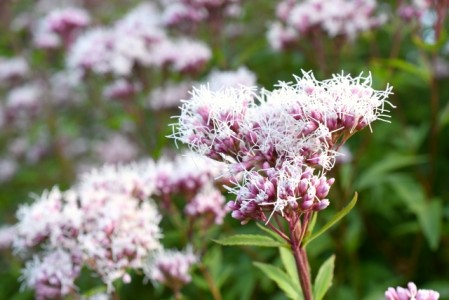
Fujibakama / 藤袴 (Joe-Pye weed)
The Joe-Pye weed is a small, pale red flower that blooms in autumn on riverbanks.
The flower appears in “The Tale of Genji,” and is also the color used in the Heian period (794-1185) in the name of the color of the garments worn over the kimono, which is purple both inside and out.
It is used in Chinese herbal medicine as a diuretic and antifebrile.

Kikyo / 桔梗 (Balloon Flower)
Purple balloon flowers (Kikyo) swaying in the wind in hills and fields remind us of the coming of autumn. Their puffy buds, which look like balloons, are also pretty.
Kikyo is also the name of a color used in the Heian period for the clothing of the nobility. The front is indigo, and the back is blue.
It is often used in Chinese herbal medicine because of its ability to soothe coughs and promote drainage of pus.
Some people think that Japanese Bindweed and Rose of Sharon can be added to the seven herbs of autumn, so below are the images and explanations of these herbs.

Hirugao / 昼顔 (Japanese Bindweed)
Japanese Bindweeds are flowers that bloom in fields and look similar to morning glories. While morning glories bloom only in the morning, Japanese Bindweeds bloom from morning to evening and remain open during the day.
Its leaves, flowers, stems, and roots of day glories can all be eaten. The leaves can be boiled and seasoned with soy sauce, tempura, or stir-fried. The flowers can be used in salads, vinegared dishes, and soups. Roots can be made into kakiage (deep-fried vegetables) or tsukudani (food boiled in soy sauce and mirin).
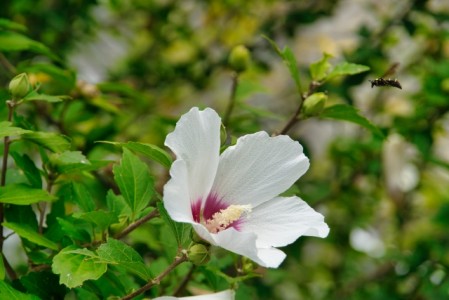
Mukuge / 木槿 (Rose of Sharon)
Known as the “Hibiscus of the Orient,” the Rose of Sharon came to Japan from China during the Nara period (710-794).
The flowers come in some colors, including white, pink, and purple.
It can be distinguished from hibiscus by the flower column that emerges from the center of the flower.
Hibiscus has a slender flower column with yellow pollen on the tip, while Rose of Sharon has stamens from the bottom to the top of the thick flower column, making it look fluffier and whiter than hibiscus.
Why don’t you take this opportunity to learn about the seven herbs of autumn?
Category : text @en
Tag : 24 divisions of the solar year , 24sekki , corona virus , COVID-19 , COVID19 , Emergency , Japanese culture , season , tanabata , The coronavirus , 日本の文化









